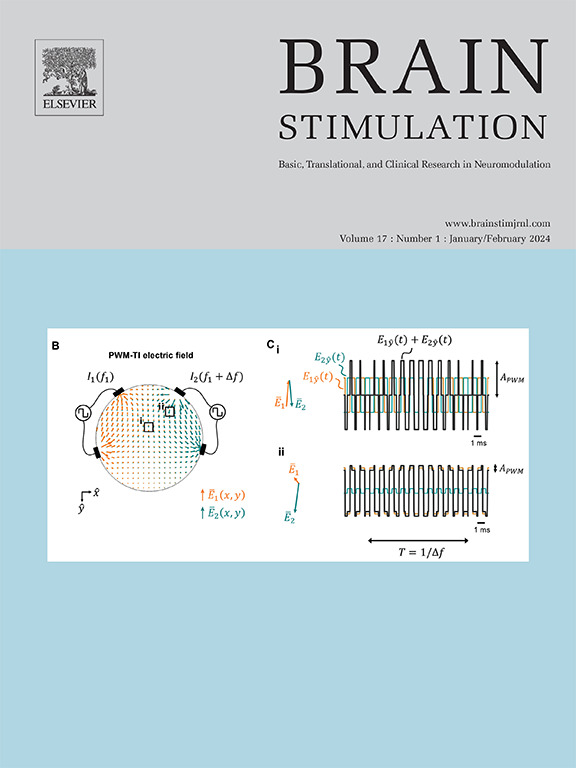Multi-locus transcranial magnetic stimulation with pulse-width modulation
IF 7.6
1区 医学
Q1 CLINICAL NEUROLOGY
引用次数: 0
Abstract
Background
In transcranial magnetic stimulation (TMS), a pulse of current driven through a coil on the scalp induces an electric field on the cortex, eliciting neuronal activation. Multi-locus TMS (mTMS) uses multiple coils to generate various electric field patterns, enabling electronic control of stimulation location and orientation. However, changing the stimulation target with mTMS can take up to a few seconds when the driving voltages are adjusted for each coil.
Objective
To investigate whether multi-coil TMS combined with pulse-width modulation (PWM) in the microsecond scale could be used to overcome the issue of rapid pulse delivery to different cortical targets.
Methods
We devised a methodology to generate and drive PWM approximations of given reference pulses. We compared resting motor thresholds (RMTs) and motor evoked potentials (MEPs) between trapezoidal and PWM pulses in several multi-coil targeting scenarios.
Results
The cortical electric field of PWM pulses had high temporal complexity, but the pulse types showed no statistically significant differences when stimulating with 2- or 3-coil combinations. With PWM pulses using five coils, the RMT increased by 9 % (p = 0.06), and MEP amplitudes decreased by 20 % with stimulation doses over 120 % RMT (p < 0.05).
Conclusions
Motor responses with trapezoidal and PWM pulses were equivalent when using two or three coils concurrently, but some differences were found with five coils. Using PWM with multi-coil TMS device to control the stimulation targets in millisecond-scale is feasible, although more research is needed to understand the neurophysiological effects of increasing coil count.
脉宽调制的多位点经颅磁刺激
在经颅磁刺激(TMS)中,通过头皮上的线圈驱动的电流脉冲在皮层上引起电场,引发神经元激活。多位点TMS (mTMS)使用多个线圈来产生不同的电场模式,从而实现电子控制刺激的位置和方向。然而,当为每个线圈调整驱动电压时,用mTMS改变刺激目标可能需要几秒钟的时间。目的探讨多线圈经颅磁刺激联用微秒级脉宽调制(PWM)技术能否克服脑皮层不同靶点的快速脉冲传递问题。方法我们设计了一种方法来产生和驱动给定参考脉冲的PWM近似值。我们比较了几种多线圈定位场景下梯形脉冲和脉宽调制脉冲的静息运动阈值(RMTs)和运动诱发电位(MEPs)。结果PWM脉冲的皮层电场具有较高的时间复杂度,但脉冲类型在2圈和3圈组合刺激下无统计学差异。使用5个线圈的PWM脉冲,刺激剂量超过120% RMT时,RMT增加了9% (p = 0.06), MEP振幅下降了20% (p <;0.05)。结论梯形脉冲和脉宽调制脉冲的电机响应在两圈和三圈同时使用时是等效的,但在五圈时存在一定的差异。利用脉宽调制与多线圈经颅磁刺激装置在毫秒级控制刺激目标是可行的,但增加线圈数对神经生理的影响还需要更多的研究。
本文章由计算机程序翻译,如有差异,请以英文原文为准。
求助全文
约1分钟内获得全文
求助全文
来源期刊

Brain Stimulation
医学-临床神经学
CiteScore
13.10
自引率
9.10%
发文量
256
审稿时长
72 days
期刊介绍:
Brain Stimulation publishes on the entire field of brain stimulation, including noninvasive and invasive techniques and technologies that alter brain function through the use of electrical, magnetic, radiowave, or focally targeted pharmacologic stimulation.
Brain Stimulation aims to be the premier journal for publication of original research in the field of neuromodulation. The journal includes: a) Original articles; b) Short Communications; c) Invited and original reviews; d) Technology and methodological perspectives (reviews of new devices, description of new methods, etc.); and e) Letters to the Editor. Special issues of the journal will be considered based on scientific merit.
 求助内容:
求助内容: 应助结果提醒方式:
应助结果提醒方式:


